Keep in mind that I'm not a Magic pro, and I've never tried making predictions before. This is a new process for me, but I hope something valuable can be found here.
Orzhov - B/W
Orzhov is an interesting guild. They combine the lifegain of white with the slow ability damage of black, and combine them to create a potential snowball effect. Take a look:
Orzhov is an interesting guild. They combine the lifegain of white with the slow ability damage of black, and combine them to create a potential snowball effect. Take a look:

I had to check this, but you can only activate each ability once per spell. That's the downside. However, Orzhov is swimming in cheap spells (1-4 cost), so casting a 2 drop on turn 5 may not put you as far behind as usual.
In constructed play, I think this will be a very powerful mechanic. If you can establish yourself with a few Extorts and then start casting cheap control spells, you can slowly whittle your opponent while creating a cushion for yourself.
In limited, I'm not so sure. Limited doesn't have as much card interaction, which is to say that most damage is dealt by turning creatures sideways. That means that every turn, you'll likely have creatures swinging for your face. That leaves you with a few options:
In constructed play, I think this will be a very powerful mechanic. If you can establish yourself with a few Extorts and then start casting cheap control spells, you can slowly whittle your opponent while creating a cushion for yourself.
In limited, I'm not so sure. Limited doesn't have as much card interaction, which is to say that most damage is dealt by turning creatures sideways. That means that every turn, you'll likely have creatures swinging for your face. That leaves you with a few options:
- Pack some removal spells and use them wisely. I'd suggest either splashing blue for this, or go WUb or BUw and go for heavy control with some light Extort damage.
- Lots of creatures with big butts that your opponents can't attack through. If you sit behind a wall and just let your opponent bleed out, be ready for everyone to hate you for taking so long.
- Play BW aggro and use Extort as a convenient ability when you can afford it. This may be your best bet in limited, as you'll rarely have wasted mana.
I think Orzhov can do well with number 3. It's a shame that you won't get to use your shiny new guild ability as a main strategy, but an extra 1-2 damage each turn can be enough to sway the game.
Dimir - BU
Tricky old Dimir. This time they're promoting recycling in the form of their Cipher ability.
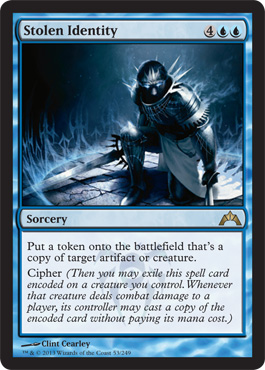

I'll break it down. You cast the original spell, and then exile it. You then choose a creature and encode it with the exiled card. When the creature deals combat damage to a player, you can cast that encoded card for free. Keep in mind that the spell is considered being cast, so it can still be countered. But still, if you have an unblockable creature, you're casting the spell every turn until they can draw some removal.
The thing I like about this is that it makes blue very splashable. Since the guild mechanic lies in instants and sorceries, you are free to build your creature base however you want. You could get away with only a handful of Cipher cards, and you'd rarely be disappointed when drawing them. And considering the cost to cast most of them, you should consider only bringing the ones that can serve as a win condition (see Stolen Identity above).
I'm having a hard time deciding how well this guild will do. The mechanic seems built for limited since you will be winning by dealing combat damage. At the same time, the cards are heavily costed because of the Cipher ability. If your opponents catch on to your plan, they will save their removal until you get a creature with Cipher on it.
Fortunately those spells will be limited, but you run a high risk of wasting mana on an overpriced spell, and odds are very good that you'll only cast the Cipher version of it once. To that end, make your Ciphers matter. Cheap is safe, but it will also likely be a wasted card slot.
If you're going Dimir, remember to pick creatures that will be able to deal damage in the mid-to-late game. Having a swarm of 2 or 3 cast creatures won't last very long when your opponent is swinging through every turn while you try to ramp up to 4 or 5 mana. Plan to win on turn 5 or 6, not turn 3.
Along with that, pay attention to your mana. This is a time where missing a mana drop on turns 1-4 can be devastating, because you're giving your opponent one more turn to get set up for your big spells. Use dual lands if you get them. Gates may be a way to go, but I still see them as missing a drop that turn, so have care with how many you take.
Gruul - GR
Gruul say "RAWR!" and that's how they want to be played. Gruul love being turned sideways and beating something in the face. To that end, their mechanic holds zero surprise:
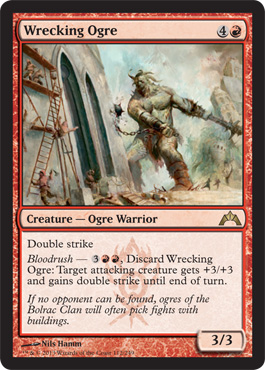
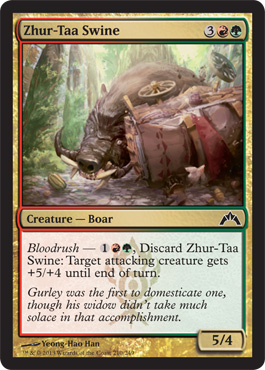
I like Gruul. They're straightforward, and they make your opponent respond to you. You either play a creature that's made to do damage, or you use Bloodrush and fuse them with one of your own creatures for one turn. If you're a newer player, Gruul isn't a bad way to go simply because you'll ask yourself two basic questions:
The thing I like about this is that it makes blue very splashable. Since the guild mechanic lies in instants and sorceries, you are free to build your creature base however you want. You could get away with only a handful of Cipher cards, and you'd rarely be disappointed when drawing them. And considering the cost to cast most of them, you should consider only bringing the ones that can serve as a win condition (see Stolen Identity above).
I'm having a hard time deciding how well this guild will do. The mechanic seems built for limited since you will be winning by dealing combat damage. At the same time, the cards are heavily costed because of the Cipher ability. If your opponents catch on to your plan, they will save their removal until you get a creature with Cipher on it.
Fortunately those spells will be limited, but you run a high risk of wasting mana on an overpriced spell, and odds are very good that you'll only cast the Cipher version of it once. To that end, make your Ciphers matter. Cheap is safe, but it will also likely be a wasted card slot.
If you're going Dimir, remember to pick creatures that will be able to deal damage in the mid-to-late game. Having a swarm of 2 or 3 cast creatures won't last very long when your opponent is swinging through every turn while you try to ramp up to 4 or 5 mana. Plan to win on turn 5 or 6, not turn 3.
Along with that, pay attention to your mana. This is a time where missing a mana drop on turns 1-4 can be devastating, because you're giving your opponent one more turn to get set up for your big spells. Use dual lands if you get them. Gates may be a way to go, but I still see them as missing a drop that turn, so have care with how many you take.
Gruul - GR
Gruul say "RAWR!" and that's how they want to be played. Gruul love being turned sideways and beating something in the face. To that end, their mechanic holds zero surprise:


I like Gruul. They're straightforward, and they make your opponent respond to you. You either play a creature that's made to do damage, or you use Bloodrush and fuse them with one of your own creatures for one turn. If you're a newer player, Gruul isn't a bad way to go simply because you'll ask yourself two basic questions:
- Are my creatures big enough to attack and do something to my opponent? If yes, attack.
- Can I attack, cast Bloodrush and then do something? If yes, attack.
That's not to say that Gruul will be simple to play. When do you pay 3 mana for a one-time boost vs paying 2 more mana and having them for good. Neither option is wrong, but it's up to you to determine which is most advantageous both initially and in the long run.
Bloodrush is a fantastic combat trick, and I think it's the guild that will elicit the most profanity from its opponents. Like Dimir, you have some cards that are usually overcosted by 1 mana to make up for their incredible ability. Unlike Dimir, you'll only be playing one of them, so that price can be hefty.
Here's how I see it. With Bloodrush, each creature becomes a beatstick on the field or an uncounterable creature-pump in your hand. You could, if you chose, play nothing but creatures and still do decently. Why play a sorcery that has no chance of becoming a creature?
I wouldn't recommend it, but that's what I love about Bloodlust. Every creature in your hand can be put on the field to pummel your opponent, or reserved and used to save a creature from death, or pump that 2/2 that your opponent doesn't block.
I included the two cards above to illustrate the good and bad of the guild. Initially it seems great no matter what. If you Bloodrush the Ogre on turn 5 or 6, you'll probably be doing it on an already beefy creature. If you can give +3/+3 and double strike do something that's at least 3/3, you're dealing 12 damage and probably ending the game. But if you don't, you're left with 1 less card and no creature to show for it. And in a deck that will rarely be holding cards, you could be left empty-handed with some (below) average creatures that your opponent can deal with.
A problem also comes in the form of "chump blocking." Unless you have kept your opponent on the ropes all game, there's a good chance they'll have a few creatures to absorb your damage. If your 3/3 is blocked by a 1/4, are you really going to waste a 6 mana creature to kill it?
And that's the fine line that Gruul needs to walk. Your best cards are meant for the late game. But if you wait until then, you'll have a hard time justifying using Bloodrush when you would probably be better served by playing it in creature-form.
Make sure you're setting yourself up for a big finish. You'll be doing chunks of damage here and there, but in the end you'll probably be taking your opponent from 10 to 0 in a single turn. Keep the pressure on your opponent, and remember that any creature you leave back to block is less damage that you're pushing through. And with minimal defensive tricks, that's a dangerous strategy to attempt.
I think Gruul will do well against opponents who can't keep up with them. They'll be able to outrun Orzhov, and will have enough tricks to stop any Dimir creature that isn't unblockable.
Bloodrush is a fantastic combat trick, and I think it's the guild that will elicit the most profanity from its opponents. Like Dimir, you have some cards that are usually overcosted by 1 mana to make up for their incredible ability. Unlike Dimir, you'll only be playing one of them, so that price can be hefty.
Here's how I see it. With Bloodrush, each creature becomes a beatstick on the field or an uncounterable creature-pump in your hand. You could, if you chose, play nothing but creatures and still do decently. Why play a sorcery that has no chance of becoming a creature?
I wouldn't recommend it, but that's what I love about Bloodlust. Every creature in your hand can be put on the field to pummel your opponent, or reserved and used to save a creature from death, or pump that 2/2 that your opponent doesn't block.
I included the two cards above to illustrate the good and bad of the guild. Initially it seems great no matter what. If you Bloodrush the Ogre on turn 5 or 6, you'll probably be doing it on an already beefy creature. If you can give +3/+3 and double strike do something that's at least 3/3, you're dealing 12 damage and probably ending the game. But if you don't, you're left with 1 less card and no creature to show for it. And in a deck that will rarely be holding cards, you could be left empty-handed with some (below) average creatures that your opponent can deal with.
A problem also comes in the form of "chump blocking." Unless you have kept your opponent on the ropes all game, there's a good chance they'll have a few creatures to absorb your damage. If your 3/3 is blocked by a 1/4, are you really going to waste a 6 mana creature to kill it?
And that's the fine line that Gruul needs to walk. Your best cards are meant for the late game. But if you wait until then, you'll have a hard time justifying using Bloodrush when you would probably be better served by playing it in creature-form.
Make sure you're setting yourself up for a big finish. You'll be doing chunks of damage here and there, but in the end you'll probably be taking your opponent from 10 to 0 in a single turn. Keep the pressure on your opponent, and remember that any creature you leave back to block is less damage that you're pushing through. And with minimal defensive tricks, that's a dangerous strategy to attempt.
I think Gruul will do well against opponents who can't keep up with them. They'll be able to outrun Orzhov, and will have enough tricks to stop any Dimir creature that isn't unblockable.
Boros - RW
Ah Boros, the guild I learned Magic with. I'll skip the prolonged nostalgia and jump right in to their very flavorful mechanic:
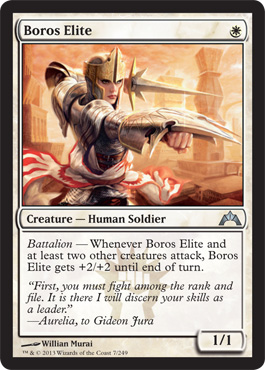

At first glance, the mechanic seems amazing. Limited loves attacking creatures, and Boros gets even better because of it. Attacking with 2 other creatures gives you a boost that is way above the cards mana cost, and none of the cards seem overcosted because of it.
However, this isn't battle-cry. The benefit goes to that creature alone, leaving your other creatures in the cold. On one hand, it makes most of your creatures a good draw no matter what turn it is. On the other hand, this mechanic makes removal spells incredibly potent.
Let's look at an idea scenario. Turn 1 Boros Elite, Turn 2 Daring Skyjek, Turn 3 _____. That means that these creatures won't be getting their Battalion benefit until turn 4. Until then, you have to sit idly by while your opponent attacks you knowing that you wouldn't dare block and let a creature die.
Then on turn 4 you're ready to attack. But at the end of your main phase, your opponent announces something like these:
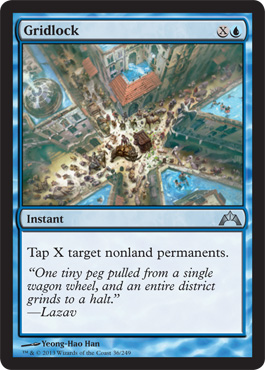
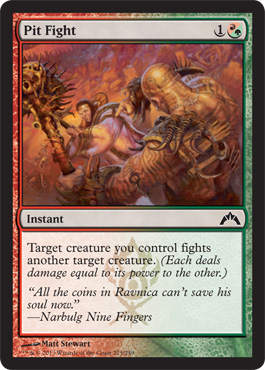
That means that you are either swinging into their untouched mass of creatures with a 3/1 and maybe a 3/3, or you're waiting until turn 5 or 6 to attack with 3 or 4 cheap creatures. I don't like it.
Boros is a good mix of red and white. Cheap, aggressive creatures are great looking, but the Battalion mechanic requires 3 of them to attack to really let them shine. And even if you get 3 attacking, odds are against you ending combat with all of them alive.
Against slow decks like Dimir, you can get a strong lead if you don't miss a drop. Just make sure you pack a strong finisher for turn 4 or 5, and plenty of ways to get their creatures out of combat.
Simic - UG
UG? More like UG - LY, and they don't have no alibi mechanic!
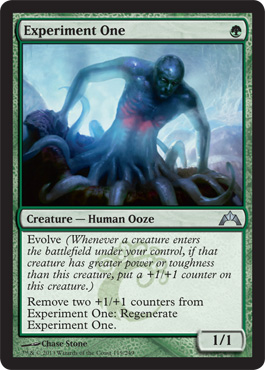
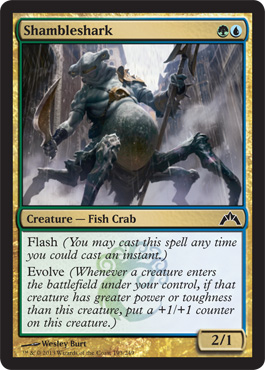
But uh... they sure are awesome.
Let me get this out of the way - I think Simic are the nastiest guild in Ravnica. They're a bunch of mad scientists sitting around and turning everything in to one, big Lovecraftian mess. That being said, I love this mechanic.
At first glance I was underwhelmed. Eventually everything will max itself, because you can only have so many creatures that are bigger than something with 1 or 2 counters on it.
But then I realized that it's based on power or toughness. That means that your 1/1 with two counters on it can get one more when your 1/4 defender hits the field. This guild just doesn't seem like it can have bad draws as long as you don't have an empty field.
And the colors for it are just right. Green is all about boosting, and there are several ways to make creatures even bigger when they hit the field. Blue loves control and card advantage, so you can find several ways to get another counter on everything you control.
Let's go through a hypothetical early game, assuming every creature you play has Evolve.
Ah Boros, the guild I learned Magic with. I'll skip the prolonged nostalgia and jump right in to their very flavorful mechanic:


At first glance, the mechanic seems amazing. Limited loves attacking creatures, and Boros gets even better because of it. Attacking with 2 other creatures gives you a boost that is way above the cards mana cost, and none of the cards seem overcosted because of it.
However, this isn't battle-cry. The benefit goes to that creature alone, leaving your other creatures in the cold. On one hand, it makes most of your creatures a good draw no matter what turn it is. On the other hand, this mechanic makes removal spells incredibly potent.
Let's look at an idea scenario. Turn 1 Boros Elite, Turn 2 Daring Skyjek, Turn 3 _____. That means that these creatures won't be getting their Battalion benefit until turn 4. Until then, you have to sit idly by while your opponent attacks you knowing that you wouldn't dare block and let a creature die.
Then on turn 4 you're ready to attack. But at the end of your main phase, your opponent announces something like these:


That means that you are either swinging into their untouched mass of creatures with a 3/1 and maybe a 3/3, or you're waiting until turn 5 or 6 to attack with 3 or 4 cheap creatures. I don't like it.
Boros is a good mix of red and white. Cheap, aggressive creatures are great looking, but the Battalion mechanic requires 3 of them to attack to really let them shine. And even if you get 3 attacking, odds are against you ending combat with all of them alive.
Against slow decks like Dimir, you can get a strong lead if you don't miss a drop. Just make sure you pack a strong finisher for turn 4 or 5, and plenty of ways to get their creatures out of combat.
Simic - UG
UG? More like UG - LY, and they don't have no alibi mechanic!


But uh... they sure are awesome.
Let me get this out of the way - I think Simic are the nastiest guild in Ravnica. They're a bunch of mad scientists sitting around and turning everything in to one, big Lovecraftian mess. That being said, I love this mechanic.
At first glance I was underwhelmed. Eventually everything will max itself, because you can only have so many creatures that are bigger than something with 1 or 2 counters on it.
But then I realized that it's based on power or toughness. That means that your 1/1 with two counters on it can get one more when your 1/4 defender hits the field. This guild just doesn't seem like it can have bad draws as long as you don't have an empty field.
And the colors for it are just right. Green is all about boosting, and there are several ways to make creatures even bigger when they hit the field. Blue loves control and card advantage, so you can find several ways to get another counter on everything you control.
Let's go through a hypothetical early game, assuming every creature you play has Evolve.
- 1/1 (0 counters)
- 2/1 (0) 1/1 (1)
- 3/3 (0) 2/1 (1) 1/1 (2)
- 1/4 (0) 3/3 (1) 2/1 (2) 1/1 (3)
On turn four, you are swinging with a 4/4, 4/3, and 4/4. That's insane and a bit unfair.
As always, removal hurts this deck. But with evolve, everything is basically the same. Your card from turn 1 and turn 3 look the same right now, so the only way to impact this deck is heavy spot removal or mass removal.
I think Simic is the guild to be. They can get some damage through in the early game, have beefy enough creatures for mid-range, and since you're green you can stick a few big finishers in for good measure (and more Mutation triggers!).
As always, removal hurts this deck. But with evolve, everything is basically the same. Your card from turn 1 and turn 3 look the same right now, so the only way to impact this deck is heavy spot removal or mass removal.
I think Simic is the guild to be. They can get some damage through in the early game, have beefy enough creatures for mid-range, and since you're green you can stick a few big finishers in for good measure (and more Mutation triggers!).
So that's my amateur predictions for tomorrow. I'll be keeping my eye on the reports to see how I did, but I have no doubt that my Simic prediction is pretty good. Let me know what you think, and if you go tomorrow be sure to let me know how your guild performed.
See you tomorrow!

No comments:
Post a Comment